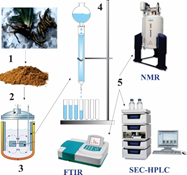
Zayniddin K. Muhidinov
Institute of Academy of Sciences of the Tajikistan Republic
Title: Characterization of a polysaccharide from Eremurus hissaricus roots growing in Tajikistan
Biography
Biography: Zayniddin K. Muhidinov
Abstract
Statement of the Problem: Roots of medical plants are important resources of bioactive compounds including a polysaccharide, many of which, have been reported to possess various biological functions. Two types of water-soluble (WSP) and acid-soluble polysaccharides (ASP) with 23% and 8% yields, the molecular weight of 495 kDa and 179 kDa respectively were obtained from the roots of Eremurus hissaricus growing in Tajikistan in dormancy periods. The crude polysaccharides after deproteinization were purified by ion-exchange and gel filtration chromatography to obtain a homogeneous polysaccharide. The monosaccharide composition of WSP and ASP were analyzed by HPAEC-PAD. WSP was composed of D- mannose and D- glucose in 1.7:1 molar ratio. ASP content includes the pectic polysaccharide. IR spectra and analysis of 2D NMR analyses of WSP provide evidence that it has a backbone of (1→4)-linked ß-D-glucopyranosyl and ß-D-mannopyranosyl. The NMR and FTIR spectra of both crude and purified WSP has no differences. This fact probably indicates that WSP has no significant impurity. The carboxyl group of WSP is highly esterified. The NMR analyses of the ASP and deproteinated ASP polysaccharides suggest that the samples are composed of rhamnose, galactose or glucose, xylose, and arabinose, with partially methyl- and acetylated carboxyl groups, which may be consistent with a branched pectic rhamnogalacturonan. Unfortunately, monosaccharide analysis has not yet been performed on these samples. The NMR spectra of the ASP-S3 sample is similar to the other two, but it appears to lack resonances assignable to xylose. It is unclear what this means. The bands at 801 cm-1 in the FTIR of the ASP samples were characteristic of the a-pyranose configuration of sugar unit of the pectin polysaccharide, while the absorption in the region of 880-890 cm-1 confirms the presence of ß-pyranose configuration of another sugar residue in the WSP.

Fig. 1. Tuber roots of Eremurus Hissaricus (1&2) and schema for extraction (3), purification of WS- and AS- polysaccharides (4) and structural analysis (5).

